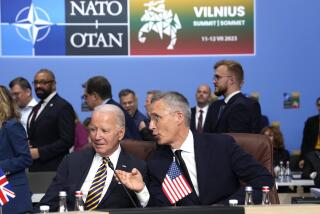Nonaligned Nations Trumpet Continuing Clout : Summit: Group meets for first time since 1992. Members believe movement can still offset major powers in post-Cold War world.
- Share via
CARTAGENA, Colombia — The movement’s renowned founding fathers are history--Nehru of India, Nasser of Egypt, Tito of Yugoslavia. So is its primary cause: to avoid dominance by one side or the other in the Cold War rivalry between East and West, Moscow and Washington. As that rivalry fades into the past, the very name of the Nonaligned Movement of nations seems to make little sense anymore.
But here it was, alive and still growing, as heads of state and government from more than 30 countries began two days of talks Wednesday. Although many analysts had speculated that the group would wither and die after the fall of the Berlin Wall and the collapse of the Soviet Union, the Nonaligned Movement is showing surprising signs of vitality at its first summit meeting since 1992.
The number of countries in the group has increased to 113 from 108 in three years. This week’s agenda focuses on many fresh issues, priorities and goals for a changing world.
“Our movement is now a center of attraction and interest for the world,” said Gabon’s President Omar Bongo in a speech Wednesday. “It is growing with new members. It has drawn many sympathizers.”
“Those who question the relevance of the Nonaligned are mistaken,” said Foreign Minister Rodrigo Pardo of Colombia in a welcoming speech to officials at a preliminary session early in the week. “Furthermore, if the movement did not exist today, we would have to take up the task of inventing it.”
For Pardo and other participants, the movement is a necessary nexus for most of the poorest, newest, smallest--and some of the biggest--nations on Earth. Together, its members account for half of the world’s population, but they are mostly have-not nations with little individual clout on the international scene. Their main strength is in numbers.
During the Cold War, the movement gave many members a hopeful spirit of unity in the shadow of the superpower struggle.
“This spirit of solidarity is an asset that it would be very silly to destroy just because the circumstances have changed,” said Joseph Cassar, a diplomat from Malta.
At the Cartagena talks, there is little concern with Cold War ideology or East-West conflict. Instead, much of the meeting has to do with differences between the industrialized countries of the “North” and the developing ones of the “South.”
Many of those differences are over economics. Nonaligned countries want better trading terms with the North, freer access to new technology, more cooperation for overcoming poverty in the South.
*
“The East-West has ended, but the North-South has not ended,” said Ambassador Shah Pakash, India’s representative to the United Nations. “While political issues receded into the background because of the end of the Cold War, there are still many nonpolitical issues that are unresolved.”
Major issues at this week’s summit include international drug trafficking, terrorism, disarmament, refugees, migration and racism, Pakash said.
“People here are extremely worried about new forms of racism, like xenophobia,” he said.
Alfred Nzo, South Africa’s foreign minister, said pressure from the Nonaligned Movement helped end apartheid in his country, which now belongs to the organization.
“This movement, throughout our struggle for national liberation, it stood by us,” Nzo said.
He predicted that the movement will continue to play an important role in international affairs.
“There should be an instrument for the South countries to cooperate, work together on development issues,” he said. “The Nonaligned Movement presents the opportunity for that kind of instrument. It also presents the opportunity for united negotiations with the countries of the North.”
*
Alfonso Botero, a Colombian who recently published a book on the Nonaligned Movement, said in an interview that the movement can serve as a counterbalance to the world’s industrial powers.
“Today the Nonaligned are the only alternative to oppose the intervention of the great powers,” Botero said. “They are the only forum for political coordination that has the capacity, that has the strength, the number of members, to present alternative proposals in the face of great power policies.”
He said the movement continues to grow “because it is the only political option, especially for the smallest countries, for entering the international arena.”
Eritrea, the former Ethiopian province, became the 112th Nonaligned country earlier this year. Turkmenistan, a former Soviet republic, became the 113th this week. Bosnia-Herzegovina has applied for membership, but some countries have opposed its entry because of continuing disputes over nationality in the former Yugoslav federation.
The Nonaligned Movement often finds consensus elusive. Its diverse membership includes bitter rivals, democracies, dictatorships and some of the last Communist countries in the world, notably Cuba and North Korea.
But Colombian President Ernesto Samper said in a speech Wednesday that the movement’s diversity is “the best material to build a new identity for the Third World based on the culture of tolerance and cooperation.”
And when Nonaligned nations take a common stand, they can exert strong influence, especially in the United Nations and other international organizations.
“With the Nonaligned at its heart, the United Nations can at last serve the peoples of the world as they must be served,” U.N. Secretary General Boutros Boutros-Ghali told the summit.
One current goal of the Nonaligned Movement is reform in the U.N. voting structure to make the United Nations more democratic.
How to expand the Security Council and limit the veto power of its permanent members has been a major topic of discussion at the Cartagena summit.
Obviously, the Nonaligned Movement’s power would be increased by a more democratic United Nations, where the Nonaligned countries make up a majority.
“Unfortunately, power is not in the hands of the movement so far, but the potential is there,” said Mamoun Kurdi, the deputy foreign minister of Saudi Arabia.
A key to the movement’s power is its leadership. While its illustrious founders are gone, it still receives strong guidance from big members such as India and Indonesia, which has chaired the group during the past three years.
Indonesian President Suharto is credited with playing a major role in revitalizing the movement by concentrating its attention on economic and social issues. In the movement’s relations with Western powers, Suharto has encouraged cooperation rather than confrontation, which had often flared up in Cold War days.
*
Cuba, one of the most confrontational Nonaligned countries, has lost influence as the Cold War rhetoric of President Fidel Castro has become less relevant.
“Except in Latin America, he’s regarded as a dead duck,” commented a European diplomat who monitors Nonaligned affairs.
In a summit speech, Castro accused Washington of attempting to subject the world to its will, and he expressed concern about “ultra-rightest sectors that seem to be gaining considerable political terrain within the United States.”
“That was the way the dreams of world domination rose up in Nazi Germany,” he said. “Except that Hitler did not possess such gigantic power.”
Castro called on the Nonaligned nations to resist as one.
“We are a power,” he said. “United we must be taken into account. We are not just spectators. This is our world too.”
This week, Colombia takes over the chair of the Nonaligned Movement until the next summit in 1998. Some analysts say the movement may be hurt by Samper’s troubles at home, where he is under investigation for allegedly receiving drug money during his 1994 political campaign. But others say the movement is in no danger because the country, and not the president, officially holds the chair.
More to Read
Sign up for Essential California
The most important California stories and recommendations in your inbox every morning.
You may occasionally receive promotional content from the Los Angeles Times.













